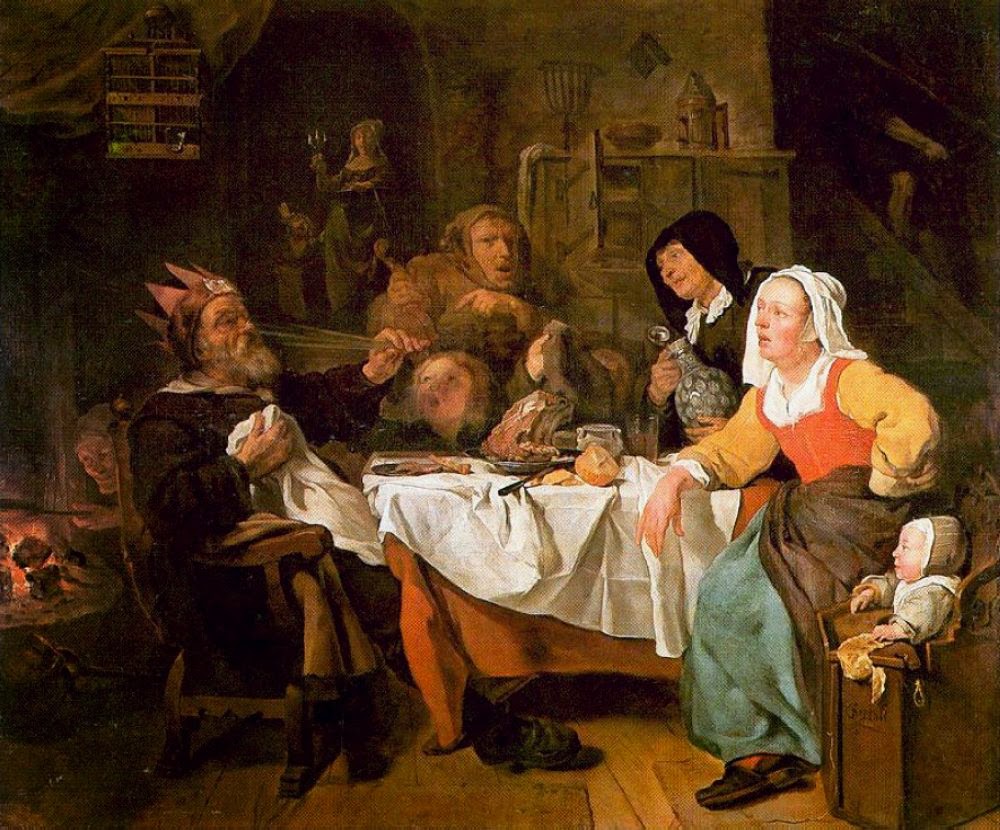It's January 5, the Twelfth Day of Christmas, and tonight will be Twelfth Night. Like so many of our seasonal celebrations, its traditions have pagan origins.
In the past Twelfth Night was characterised by feasting and games, mumming and revelry. A Lord of Misrule was appointed as games master to preside--and command--the festivities. Plays and masques were presented (Shakespeare's Twelfth Night might have got its title from an association with court celebrations.)
Though now many people remove their Christmas greenery on or before Twelfth Night, in years past this was considered unlucky and the decorations remained in place until Candlemas (2nd February).
A special Twelfth Night cake was baked--the typical festive English fruit cake, perhaps decorated with elaborate icing and devices in almond paste--containing a pea and a bean. Those who received the hidden prize were crowned King and Queen.
Here is a 17th century recipe for A Very Good Cake:
Take 4 quarts of fine flour, 2 pound and a half of butter, 3 quarters of a pound of sugar, four nutmegs, a little mace, a pound of almonds finely beaten, half a pint of sack, a pint of good ale-yeast, a pint of boiled cream, 12 yolks and 4 whites of eggs, 4 pound of currants. When you have wrought all these into a very fine paste, let it be kept warm before the fire half an hour before you set it into the oven. If you please, you may put into it 2 pound of raisins of the sun stone and quartered. Let your oven be of a temperate heat, and let your cake stand therein 2 hours and a half before you ice it, and afterwards only to harden the ice. The ice for this cake is made thus: Take the whites of 3 new-laid eggs, and 3 quarters of a pound of fine sugar finely beaten, beat it well together with the whites of the eggs, and ice the cake. If you please you may add a little musk or ambergris.
O Apple Tree, O Apple Tree,
We've come to Wassail Thee!
Other areas had specific local traditions--processions, or a form of trick-or-treating or begging for favours.
Syllabub
This was a popular drink at festive times, made from cream and eggs and wine. Here are two 17th century recipes for whipped syllabub:
Take a pint of cream with a little orange-flower water or 2 or 3 ounces of fine sugar, the juice of a lemon, the whites of 3 eggs.
Whisk these together and having in your glasses Rhenish wine and sugar and claret and sugar, lay on the froth with a spoon heaped up as light as you can.
Take the white of 2 eggs, and a pint of Cream, six spoonfuls of sack, as much sugar as will sweeten it; then take a Birchen rod and whip it; as it riseth with froth, skim it, and put it into the Syllabub pot; so continue it with whipping and skimming, till your Syllabub pot be full.
When I was little my mother often made syllabub during the Christmas season, and even though she used an old-fashioned churn like the one below instead of a special pot for the purpose or a "Birchen rod", it seemed to take forever for the whipping and the frothing to be finished. I don't remember whether the children's servings had wine!
For making the syllabub in the photo above, I used a wire whisk, and didn't froth it nearly long enough!
In A Pledge of Better Times, my novel of the 17th century royal court, a significant development occurs at a Twelfth Night ball at Kensington Palace in 1692. Here's a description of the event by a diarist of the period:
Great doings last night at Kensington in imitation of the
apartments at Versailles, all the rooms were full of ladies and men . . . . Dice,
cards and dance were the divertissements; tea, chocolate and other liquors, and
sweetmeats were the entertainments and refreshments.
I hope you enjoy your own Twelfth Night revels!



